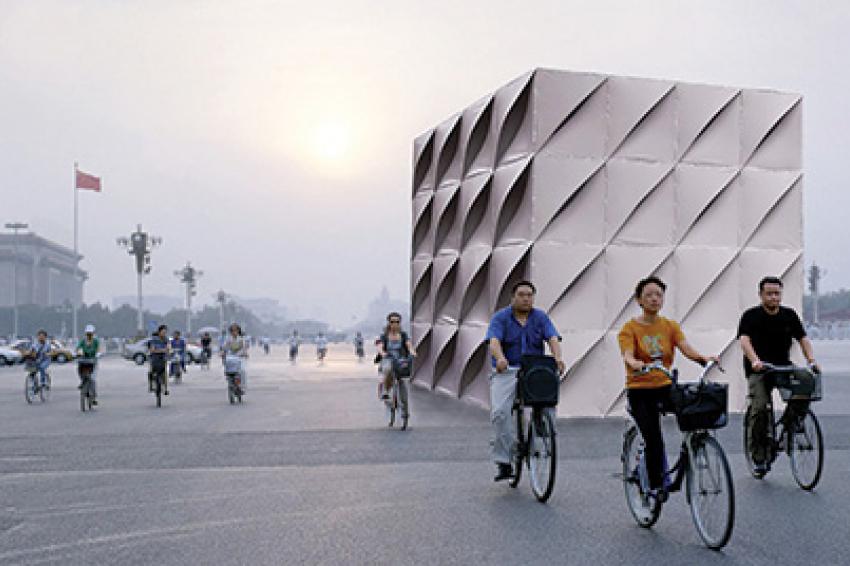Energy Efficient Building
Plastics in Building Envelopes
The energy consumption in Germany based on buildings is approximately a third part of the total amount. This reflects the strong need for sustainability in construction products, to support the reduction of 40% greenhouse gases on the level of 1990 by requirement of the German government.
Today's architectural building conceptions not only represent creative designs and urban planning, the detailed planning of functionality regarding content and energetic aspects is also enclosed. This generates a new field of activity for planners concerning the deep down involvement of all construction materials in use of building elements.
The third skin
The building envelope, in architecture nick-named "third skin", is the most crucial element in regulating the energetic needs of buildings. On the one hand the "third skin" has to protect, as a barrier, the indoor climate against outside weather condition. On the other hand this "third skin" has to be permeable, because of climate exchange (e.g. fresh air, vapor diffusion) between indoor and outdoor. And on top it should be suitable in all different worldwide regions and building designs.
The protection against cold and heat in building envelopes is mainly rated with the λ-value (U-value in building elements) on thermal conductivity for insulating materials. Plastic foams, e.g. EPS, PU, et al. are very efficient in thermal insulation systems and reduces the energy consumption enormously.
This aspect contains the strong opportunity for the reduction of energy consumption in buildings and lowering the worldwide greenhouse effect. Buildings will be more insulated in future following the motto "the more, the better"! The result of this generates an enhanced technical support in ventilation, because we - the residents - produce emissions (e.g. humidity, CO2, waste heat, smell, etc.), which have to be deleted to sustain a comfortable healthy indoor climate environment.
In-house facilities vs. building envelopes
Individually and mechanically ventilation systems will be the basis for low-energy and passive houses. Building envelopes and in-house facilities have to be understood as a common system. Indoor and outdoor sensor technology control the environment for a comfortable indoor climate and the building envelope transfers the corresponding needs, e.g. exchange of air, between indoor and outdoor.
We used to have a standard indoor climate year round. Opening a window to ventilate the room as a regulatory measure, is a relict of the past. Today, we, as residents, can destroy the automatic control engineered climate system by opening windows.
Smart building envelopes, an opportunity?
Intelligent and reactive facades could implement the control engineering for ventilation and air conditioning beside the protection and insulation against bad weather conditions. Plastics can implement reactive properties (e.g. thermal-reactive properties). Could a smart building envelope based on polymers react to environmental influences independently like our skin and what would it look like?
In 2014, the exhibition series "LABORE 1" of the gallery of the "Bundes Deutscher Architekten" (BDA) in Berlin, presented a concept for intelligent facade systems, the result of an integrative teaching and research project named "30 CHAMAELEONS" by the architectural faculty of the "Westsächsischen Hochschule Zwickau" (WHZ) dept. of Prof. Frank Schüler in cooperation with faculty mechanical and production engineering and "Das Kunststoff-Zentrum" (SKZ) represented by Thoralf Krause. (2)
On exhibition, modules of glass fiber reinforced plastic boxes which imitate the functionality of a chameleon skin. Paraffin filled containers, used as a „stretch-element", expand under the influence of heat, push a piston out of the container and press artificial pigment cells. The system adapts to light transmission and color intensity of sunlight as well as temperature. (3)
An additional project at the architectural faculty WHZ is the "KIEMENBOX" taken from gills of a fish. The building skin uses the different thermal expansion of polymers due to different thermal expansion coefficients. The bonded plastic material changes its length if temperature changes. The slit within the facade membrane opens and closes gill-like and is steered only by environmental temperature for the air exchange between indoor and outdoor. (4)
These examples show the possibilities of smart materials and building elements within building envelopes, which integrate their own regulatory mechanisms - an approach for a real "Third Skin"! Plastic materials are first in row in the field of smart materials in buildings, because of their adjustable and controllable properties and consistent quality within an industrial production process.
This knowledge about materials - especially plastics - will increasingly be required by architects and civil engineers, generating use in sustainable building designs. These competences must be integrated within the learning process and supported by relevant industries. The "institute for construction with synthetic materials - IBK" (Institut für Bauen mit Kunststoffen) supports universities by lectureships about "plastics in architecture". By these means, the IBK combines polymer-, material- and engineering science in context with architectural designs to generate sustainable buildings in the future.
Contact
Institut für das Bauen mit Kunststoffen









